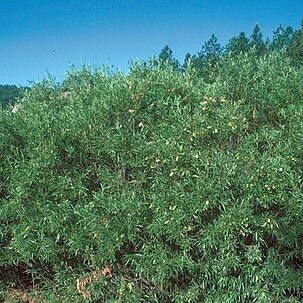Stems: branches divaricate, sometimes ± brittle at base, yellow-brown to dark red-brown, not or weakly glaucous, pilose to glabrescent, peeled wood often with very dense striae, to 25 mm; branchlets yellow-green or red-brown, moderately to very densely villous to glabrescent. Leaves: stipules rudimentary or absent on early ones, apex acute, acuminate, or convex; petiole convex to flat adaxially, 2-5.5-13 mm, pubescent adaxially; largest medial blade narrowly oblong, narrowly elliptic, elliptic, oblanceolate, or obovate, 20-44-87 × 10-16-45 mm, base cuneate, convex, or rounded, margins flat, entire, crenate, or irregularly serrate, glands submarginal, apex acute, acuminate, or convex, abaxial surface glaucous, moderately densely pubescent or long-silky to glabrescent, hairs white or gray, wavy, adaxial finely impressed-reticulate, dull or slightly glossy, moderately densely pubescent, sparsely short-silky, or glabrescent, hairs white or gray; proximal blade margins entire, gland-dotted; juvenile blade yellowish green or reddish, pilose or sparsely to moderately densely tomentose or long-silky abaxially, hairs white. Catkins: staminate flowering just before leaves emerge, pistillate flowering as leaves emerge; staminate stout to globose, 10-42 × 7-16 mm, flowering branchlet 0.5-11 mm; pistillate loosely flowered, stout, slender, or subglobose, 16.5-85 × 9-32 mm, flowering branchlet 1-26 mm; floral bract tawny, 1.2-3.2 mm, apex rounded, abaxially hairy to glabrescent, hairs straight or wavy. Staminate flowers: adaxial nectary oblong or ovate, 0.3-0.8 mm; filaments distinct or connate less than 1/2 their lengths, glabrous or hairy on proximal 1/2; anthers yellow or purple turning yellow, ellipsoid or shortly cylindrical, 0.5-0.8 mm. Pistillate flowers: adaxial nectary oblong or square, 0.3-0.8 mm; ovary obclavate, beak slightly bulged below styles (long-beaked); ovules 6-16 per ovary; styles 0.1-0.4 mm; stigmas slenderly to broadly cylindrical. Capsules 5-9 mm. 2n = 38.
More
Shrub or small tree 2–5 m, with one or few stems; twigs slender, divaricate, brownish, hairy to glabrate; stipules mostly small or none; lvs elliptic to broadly rhombic-oblanceolate or obovate-oval, acute or abruptly short-acuminate, 4–8(–10) × 1.5–3(–4) cm, subentire to undulate-crenate, glaucous and rugose-reticulate beneath, ± gray-hairy on both sides, but sometimes eventually glabrate; catkins subprecocious, the staminate small, subsessile, the pistillate 2–7 cm, very lax, on bracteate peduncles 5–20 mm; scales 1–2 mm, greenish-yellow with reddish tip, pilose; stamens 2; frs lanceolate-rostrate, 7–10 mm, finely hairy; pedicels 3–6 mm, finely hairy; style 0.1–0.4 mm; 2n=38. Moist or wet places; Nf. to Alas., s. to N.J., Md., Ill., S.D., and Ariz. (S. rostrata Richardson, not Thuill.)
An erect shrub. It grows 1-6 m tall. The crown is rounded. The trunks are in a clump. They are 6-15 cm across. The leaf shape varies.


